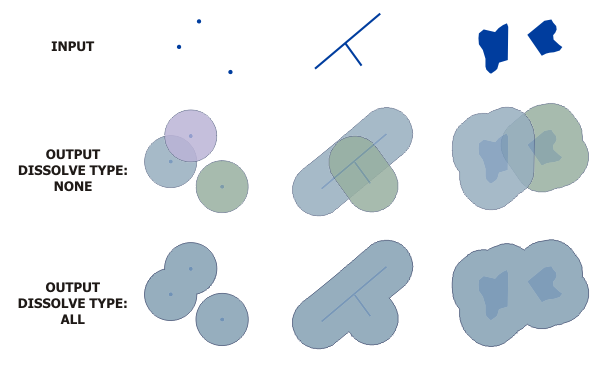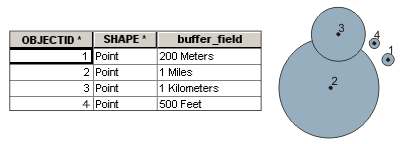Summary
Creates buffer polygons around input features to a specified distance.
Illustration

Usage
As described in How Buffer works, an important feature of the Buffer tool is the Method parameter, which determines how buffers are constructed. The two basic methods for constructing buffers, Euclidean and geodesic, are described as follows:
- Euclidean buffers measure distance in a two-dimensional Cartesian plane, where straight-line or Euclidean distances are calculated between two points on a flat surface (the Cartesian plane). Euclidean buffers are the more common type of buffer and are appropriate when you're analyzing distances around features in a projected coordinate system that are concentrated in a relatively small area (such as one UTM zone).
- Geodesic buffers account for the actual shape of the earth (an ellipsoid, or more properly, a geoid). Distances
are calculated between two points on a curved surface (the geoid) as opposed to two points on a flat surface (the Cartesian plane). You should always consider creating geodesic
in the following circumstances:
- Your input features are dispersed (cover multiple UTM zones, large regions, or even the entire globe).
- The spatial reference (map projection) of your input features distorts distances to preserve other properties such as area.
The Method parameter determines how buffers are created.
- Planar (method = "PLANAR" in Python) is the default option. This option will automatically determine which method to use based on the coordinate system of the input.
- If the input features have a projected coordinate system, Euclidean buffers will be created.
- If the input features have a geographic coordinate system and you specify a Buffer Distance value in linear units (meters, feet, and so forth, as opposed to angular units such as degrees), geodesic buffers will be created.
- This option produces the same result as the Buffer tool prior to ArcGIS 10.3.
- Geodesic (method = "GEODESIC" in Python) creates a shape-preserving geodesic buffer regardless of the input coordinate system. The shape-preserving geodesic buffer densifies the input features prior to creating the output geodesic buffers to create buffers that more closely represent the input features' shape. If you are concerned about the shape of your buffers and how closely their shape matches the original input features, it is recommended that you investigate using this option, particularly when your input data is in a geographic coordinate system. In some cases, this may take more time than the geodesic buffer created using the Planar option, but the result is a buffer that more accurately matches the shape of the input feature.
When using the Planar method, you can improve the accuracy of buffers created with projected inputs using a projection that minimizes distance distortion, such as an Equidistant Conic or an Azimuthal Equidistant projection, and is geographically appropriate for your input.
When buffering features in a projected coordinate system with output to a geodatabase feature class, the geometries created may contain circular arc segments (when buffering points, the output will always be circular arcs). If buffers containing circular arcs are reprojected to a different coordinate system, the location and size of the original buffers will be transformed, but the shape of the buffers will not change, causing the reprojected buffers to no longer accurately represent the area covered by the original buffer. If you reproject buffers containing circular arcs, first use the Densify tool to convert circular arc segments to straight lines, Then reproject the densified buffers.
The output feature class will include a BUFF_DIST field that contains the buffer distance used to buffer each feature in the linear unit of the input's coordinate system. When using the Geodesic method to create buffers, the buffer distance entered will be converted to meters in all cases.
If a field named BUFF_DIST exists in the input, its values will be overwritten in the output. If a Dissolve Type of All or List (ALL or LIST in Python) is used, the output will not include this field.
The output feature class will include a ORIG_FID field that contains the feature ID of the input feature for which the buffer was created. If a field named ORIG_FID exists in the input, its values will be overwritten in the output. If a Dissolve Type of All or List is used, the output will not include this field.
When buffering polygon features, negative buffer distances can be used to create buffers inside the polygon features. Using a negative buffer distance will reduce the polygons' boundaries by the distance specified.
If a field from the input is used to obtain buffer distances, the field's values can be either a number (5, for example) or a number with a valid linear unit (5 Kilometers, for example). If a field value is a number, it is assumed that the distance is in the linear unit of the input's spatial reference (unless the input is in a geographic coordinate system, in which case, the value is assumed to be in meters). If the linear unit specified in the field values is invalid or not recognized, the linear unit of the input's spatial reference will be used by default.

-
The Add Field button in the Dissolve Field(s) parameter is used only in ModelBuilder. In ModelBuilder, when the preceding tool has not been run or its derived data does not exist, the Dissolve Field(s) parameter may not be populated with field names. The Add Field button allows you to add expected fields to the Dissolve Field(s) list to complete the Buffer tool dialog box.
Syntax
arcpy.analysis.Buffer(in_features, out_feature_class, buffer_distance_or_field, {line_side}, {line_end_type}, {dissolve_option}, {dissolve_field}, {method})| Parameter | Explanation | Data Type |
in_features |
The input point, line, or polygon features to be buffered. | Feature Layer |
out_feature_class |
The feature class containing the output buffers. | Feature Class |
buffer_distance_or_field |
The distance around the input features that will be buffered. Distances can be provided as either a value representing a linear distance or as a field from the input features that contains the distance to buffer each feature. If linear units are not specified or are entered as Unknown, the linear unit of the input features' spatial reference is used. When specifying a distance, if the desired linear unit has two words, such as Decimal Degrees, combine the two words into one (for example, 20 DecimalDegrees). | Linear Unit; Field |
line_side (Optional) |
Specifies the sides of the input features that will be buffered.
| String |
line_end_type (Optional) |
Specifies the shape of the buffer at the end of line input features. This parameter is not valid for polygon input features.
| String |
dissolve_option (Optional) |
Specifies the type of dissolve to be performed to remove buffer overlap.
| String |
dissolve_field [dissolve_field,...] (Optional) |
The list of fields from the input features on which the output buffers will be dissolved. Any buffers sharing attribute values in the listed fields (carried over from the input features) will be dissolved. | Field |
method (Optional) |
Specifies the method to use, planar or geodesic, to create the buffer.
| String |
Code sample
Buffer example 1 (Python window)
The following Python window script demonstrates how to use the Buffer tool.
import arcpy
arcpy.env.workspace = "C:/data"
arcpy.Buffer_analysis("roads", "C:/output/majorrdsBuffered", "100 Feet", "FULL",
"ROUND", "LIST", "Distance")
Buffer example 2 (stand-alone script)
Find areas of suitable vegetation that exclude areas heavily impacted by major roads.
# Name: Buffer.py
# Description: Find areas of suitable vegetation which exclude areas heavily
# impacted by major roads
# import system modules
import arcpy
from arcpy import env
# Set environment settings
env.workspace = "C:/data/Habitat_Analysis.gdb"
# Select suitable vegetation patches from all vegetation
veg = "vegtype"
suitableVeg = "C:/output/Output.gdb/suitable_vegetation"
whereClause = "HABITAT = 1"
arcpy.Select_analysis(veg, suitableVeg, whereClause)
# Buffer areas of impact around major roads
roads = "majorrds"
roadsBuffer = "C:/output/Output.gdb/buffer_output"
distanceField = "Distance"
sideType = "FULL"
endType = "ROUND"
dissolveType = "LIST"
dissolveField = "Distance"
arcpy.Buffer_analysis(roads, roadsBuffer, distanceField, sideType, endType,
dissolveType, dissolveField)
# Erase areas of impact around major roads from the suitable vegetation patches
eraseOutput = "C:/output/Output.gdb/suitable_vegetation_minus_roads"
xyTol = "1 Meters"
arcpy.Erase_analysis(suitableVeg, roadsBuffer, eraseOutput, xyTol)
Environments
- Default Output Z Value
- M Resolution
- M Tolerance
- Output M Domain
- Output XY Domain
- Output Z Domain
- Output Coordinate System
- Extent
- Output Spatial Grid 1
- Output Spatial Grid 2
- Output Spatial Grid 3
- Current Workspace
- Geographic Transformations
- Scratch Workspace
- Output has M values
- Output has Z values
- XY Resolution
- XY Tolerance
- Z Resolution
- Z Tolerance
Licensing information
- Basic: Limited
- Standard: Limited
- Advanced: Yes